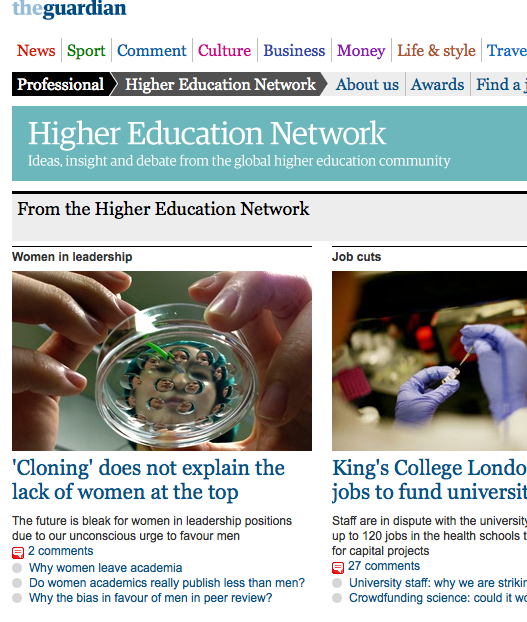Today I published three different articles on three different sites: the Guardian, The Conversation, and DiscovHer.
After a quarter of a century living among taciturn Vikings, it isn’t easy to say this aloud. Indeed, it’s almost embarrassing. But I’m trying to get past that. 🙂
All three articles reflect my interest in gender balance in the workplace, each in different ways.
 Cloning in the Guardian
Cloning in the Guardian
‘Cloning’ does not explain the lack of women at the top discusses the low number of women who lead universities. In the United Kingdom, only 17% of institutions of higher education are led by women. Some recently discussed interviews formulate one hypothesis. As I wrote in the Guardian:
Those women raised the possibility of “cloning” as an explanation for hiring disproportionately many men. “One pointed out that: ‘many of the selections are made by white-haired, ageing, middle-class men’.”
My argument is that this may be a spurious correlation, based on the research on implicit bias showing that men and women alike favor men:
On the one hand, it is likely that the men making decisions are favouring men. On the other hand, women would do the same.
Cloning is not the explanation, even if the results of hiring processes will spuriously have that appearance when men are responsible. Rather, the explanation is pure and unadulterated favouritism towards men, regardless of who does the hiring.
The glass wall in tennis on The Conversation
Twitter and the tennis world have been abuzz with the news that tennis pro Andy Murray has hired a woman as his coach. That reminded me of a piece I wrote on my blog a while back called The glass wall: a lesson from coaches for women in academia. So, I whipped up a revised version of that for The Conversation, pointing out the imbalance in career possibilities for male and female coaches. It got the title Amelie Mauresmo and Andy Murray smash the sports coaching glass wall.
Glass walls obstruct lateral movement and they are ubiquitous in the gender-imbalanced world of athletic coaching. Glass walls prevent women from coaching men in sports, but allow men to coach women.
It’s a well-documented phenomenon, and probably another example of implicit bias making career paths different for men and women.
A little more than 40% of women’s athletics teams are coached by women, while about 3% of men’s teams are coached by women. Do the maths: that means men are coaching 60% of women’s teams and 97% of mens teams.
Sex makes your research better at L’Oreal
The L’Oreal Foundation makes profound investments to advance women in science, including the development of the DiscovHer site. My publication there is about the importance of including sex in the formulation of research questions, and it’s called Sex is making research better.
The way scientists formulate research questions and the methods they use directly affect their potential relevance. And questions and methods often overlook females. Why should all of society fund research that benefits only half of us?
I describe in this piece how research gets better with these perspectives, how funding organizations are getting engaged, and how journals are beginning to require more information of this type about research they publish.
This triumvirate of pressures — the promise of enhanced quality, the demands of funding organizations, and new requirements from journals — is bringing much more attention to gendered perspectives in science.
(I’m working through my leadership of Norway’s Committee on Gender Balance in Research — in a partnership with the Research Council of Norway — to organize a conference on gendered perspectives in science, that will probably be held in January in Oslo. Watch this space for more information, and then join us.)
Now that I’m completely over-exposed, I should probably shut-up for a while. I am trying to write a book on implicit bias, after all.
Share
No Comments
Republish
I encourage you to republish this article online and in print, under the following conditions.
- You have to credit the author.
- If you’re republishing online, you must use our page view counter and link to its appearance here (included in the bottom of the HTML code), and include links from the story. In short, this means you should grab the html code below the post and use all of it.
- Unless otherwise noted, all my pieces here have a Creative Commons Attribution licence -- CC BY 4.0 -- and you must follow the (extremely minimal) conditions of that license.
- Keeping all this in mind, please take this work and spread it wherever it suits you to do so!

Discuss